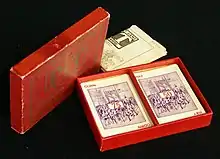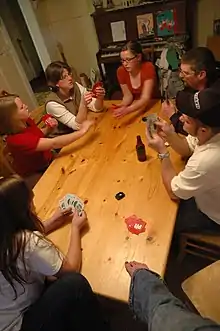 The box and cards for Pit | |
| Publishers | Parker Brothers (Hasbro) |
|---|---|
| Years active | 1904–present |
| Genres | Trading card game |
| Players | 3 to 8 players |
| Setup time | 1 to 2 minutes |
| Playing time | 1 to 10 minutes per round, any number of rounds |
| Chance | Dealing cards, blind trades |
| Skills | Hand management, Deal making |
Pit is a fast-paced card game for three to eight players, designed to simulate open outcry bidding for commodities. The game first went on sale in 1904 by the American games company Parker Brothers, having been developed by the clairvoyant Edgar Cayce.[1][2]
The inspirations were the Chicago Board of Trade (known as 'The Pit') and the US Corn Exchange. The game itself was likely based on the very successful game Gavitt's Stock Exchange, invented in 1903 by Harry E. Gavitt of Topeka, Kansas.
While the name Pit remains trademarked in many countries by Hasbro, versions of the game have been marketed under names, including Billionaire, Business, Cambio, Deluxe Pit, Quick 7, Zaster.[2]
Contents
Different versions of the game contain different numbers of cards. The original edition has 63 cards, with nine cards each of the seven different commodities. Later editions added an eighth commodity, along with a Bear card and a Bull card, for 74 cards total.
Originally, the commodities and values were:
| Commodity | Value |
|---|---|
| Wheat | 100 |
| Barley | 85 |
| Corn | 75 |
| Rye | 70 |
| Oats | 60 |
| Hay | 50 |
| Flax | 40 |
Newer versions include seven or eight commodities, with Flax, Hay and Rye removed from the list of commodities:
| Commodity | Value |
|---|---|
| Wheat | 100 |
| Barley | 85 |
| Coffee | 80 |
| Corn | 75 |
| Sugar | 65 |
| Oats | 60 |
| Soybeans | 55 |
| Oranges | 50 |
The 100th anniversary edition, released in 2004, included a reproduction of the original edition as well as a brand new edition that featured 8 "modernized" commodities:
| Commodity | Value |
|---|---|
| Cocoa | 100 |
| Platinum | 85 |
| Gold | 80 |
| Cattle | 75 |
| Oil | 65 |
| Rice | 60 |
| Silver | 55 |
| Gas | 50 |
Versions of the game starting in the 1970s contained a bell used to start trading. The first player to hold all nine cards of a commodity would ring the bell.[2]
Play

The number of commodities included in each round is equal to the number of players. Each player is dealt nine cards; two players get ten if the Bear and the Bull are included in play.
Pit has no turns and everyone plays at once. Players trade commodities among one another by each blindly exchanging one to four cards of the same commodity. The trading process involves calling out the number of cards one wishes to trade until another player holds out an equal number of commodity cards. The two parties then exchange the cards face down.
Winning
As soon as a player has nine cards of the same commodity in hand, they must reveal their entire hand (e.g. by throwing the cards onto the middle, or the corner board if available) and call out "Corner on (the name of the commodity they are holding)!", ending the round. That player then earns points equal to the number value of the commodity they were holding. In deluxe editions of the game, the player with a full set of nine has to ring the bell before revealing their hand.
The first player to reach an agreed-upon point total wins the game.
The Bear and the Bull
The Bear card serves as a hazard for all players, as its holder may not declare a Corner even while holding all cards of the same commodity.
The Bull card is considered wild and can be used to complete any set. When it is in play, a player can win a round in any of the following ways:
- Holding all nine cards of the same commodity, as described above, with or without a tenth card in hand
- Holding eight cards of one commodity and the Bull ("Bull Corner")
- Holding all nine cards of the same commodity and the Bull ("Double Bull Corner"), which awards double value
At the end of a round, the Bear and the Bull each impose a 20-point penalty on any non-winning player holding them. It is possible for a player's score to go below zero. The Bull and Bear may be traded individually or with any number of cards of one commodity. However, the four-card limit for a single trade still applies.
Reviews
References
- ↑ Bro, Harmon (1997). A Seer out of Season. New York: St. Martin's. p. 305. ISBN 0-312-95988-5. citing article "The Pit: Copies of Game Invented by Bowling Green Man Received Here". Bowling Green Times Journal. 1904.
- 1 2 3 History of Pit at boardgamegeek.com. Accessed August 2007
- ↑ "Games and Puzzles 1972-12: Iss 8". A H C Publications. December 1972.
- ↑ "GAMES Magazine #20". November 1980.
- ↑ https://archive.org/details/familygames100be0000unse/page/262/mode/2up
